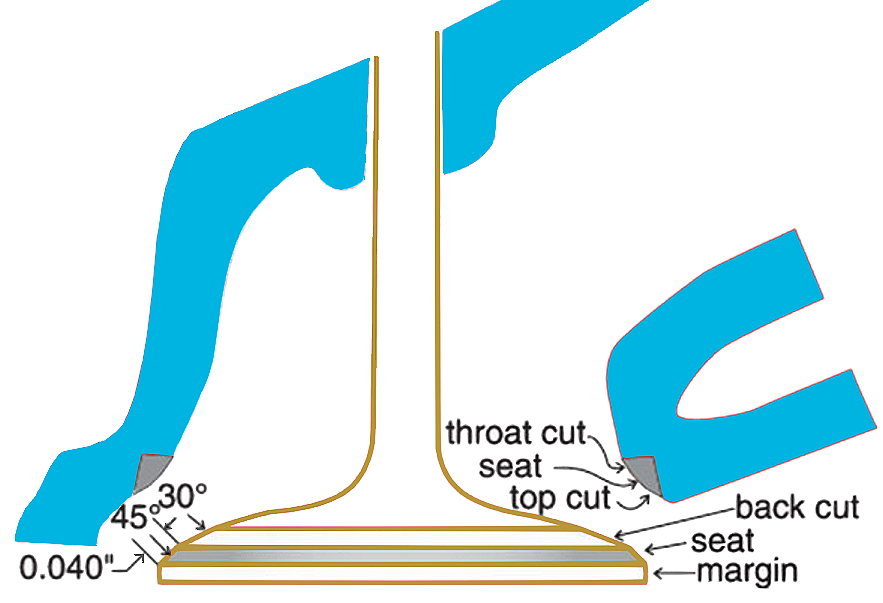Perfect Harmony: Understanding Valve Sealing Geometry in Engine Refacing
When it comes to getting maximum power and efficiency out of an engine, every tiny detail matters. One critical area is how the engine's valves seal against the cylinder head. It's not just about getting them smooth – it's about getting the angles just right. Today, we're diving into "sealing geometry": specifically, the valve face angle, seat angle, and seat width.
The Dynamic Duo: Valve Face and Seat Angles
Imagine trying to perfectly seal two pieces of glass together. If their surfaces don't match precisely, there will be tiny gaps. In an engine, these gaps mean lost compression, less power, and even burnt valves. This is why the valve face (the angled edge of the valve head) and the valve seat (the angled surface in the cylinder head that the valve rests on) are so important.
Most commonly, you'll find these angles around 45 degrees. However, it's not always a perfect match:
- The 45-degree angle: This is the workhorse angle. It provides a good balance between sealing effectiveness and airflow. Most passenger cars use a 45-degree angle for both the valve face and seat.
- The "Interference Angle": Sometimes, to ensure a faster and more positive seal, the valve face is ground at a slightly smaller angle than the seat. For example, a 44-degree valve face might meet a 45-degree valve seat. This creates a tiny interference when the valve first contacts the seat, ensuring the outer edge of the valve face makes initial contact and then "wipes" into the seat as it fully closes. This helps to break through any carbon deposits for a tighter seal. It's like gently squeezing two cones together – they eventually form a perfect ring of contact.
- The 30-degree angle: In some high-performance or older engines, you might see 30-degree angles. This angle generally promotes better airflow when the valve is open, which is great for getting more air and fuel into the cylinder. However, the sealing surface is wider and can be more prone to carbon buildup.
When refacing a valve, you will use a specialized grinding machine to cut the valve face to the precise angle specified by the engine manufacturer. Similarly, the valve seat in the cylinder head is also re-cut or ground to its correct angle. These two surfaces must meet perfectly for a tight seal.
The Goldilocks Zone: Seat Width
Once the angles are perfect, the next crucial element is the seat width. This is the actual contact area, the "ring" where the valve face touches the valve seat in the cylinder head.
Here's why seat width is like the "Goldilocks Zone" – it has to be just right:
- Too Wide: A seat that's too wide means a larger area for carbon to build up, which can prevent a perfect seal. It also can reduce the pressure applied per square inch, potentially leading to less effective sealing. In some cases, a wide seat might transfer heat less efficiently from the valve, leading to overheating and premature wear.
- Too Narrow: A seat that's too narrow puts a lot of pressure on a tiny area. While this can initially provide a strong seal, it also means:
- Less Heat Transfer: Valves get incredibly hot, and they shed a lot of that heat through contact with the valve seat. A narrow seat provides less surface area for heat to escape, which can lead to the valve overheating and burning.
- Pounding: A narrow seat can cause the valve to "pound" into the seat, leading to excessive wear on both surfaces.
- Weak Seal Over Time: It's more susceptible to damage from even small bits of debris or carbon.
Common Practice: For most automotive applications, an optimal seat width typically ranges from 1mm to 2mm (about 0.040 to 0.080 inches). Precision high-performance engines might aim for the narrower end of that spectrum, while heavy-duty truck engines might be slightly wider.
How is Seat Width Achieved?
This is where the magic of "three-angle valve jobs" comes in. Besides the main 45-degree seat angle, mechanics use two (or more) other angles:
- Top Cut/Relief Angle (e.g., 30 degrees): This angle is cut above the main seat angle. It "relieves" the top edge of the seat, moving the contact point down and helping to narrow the seat. It also helps improve airflow into the combustion chamber.
- Bottom Cut/Throat Angle (e.g., 60 or 75 degrees): This angle is cut below the main seat angle. It "relieves" the bottom edge, moving the contact point up and again helping to define and narrow the seat. It's also crucial for airflow out of the port.
By carefully cutting these three angles, a skilled machinist can create a perfectly positioned, precise width valve seat that optimizes both sealing and airflow.
Why Does All This Matter?
Getting the sealing geometry right is crucial for:
- Engine Performance: A perfect seal means no lost compression, translating directly to more power and torque.
- Fuel Efficiency: Better sealing means more efficient combustion and less wasted fuel.
- Engine Longevity: Proper heat transfer prevents valves from burning out, and correct contact prevents premature wear on both the valve and the cylinder head seat.
- Emissions: A good seal ensures complete combustion, reducing harmful exhaust emissions.
Next time you hear about an engine needing a "valve job," you'll know there's a lot more to it than just making things shiny. It's a precise art of angles and widths, ensuring every tiny door in your engine works in perfect harmony!


